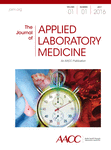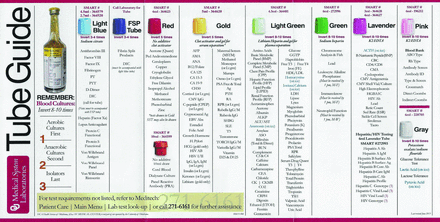-
PDF
- Split View
-
Views
-
Cite
Cite
Kenneth E Blick, Clinical Chemistry Residency Training Program at the Oklahoma University Medical Center, The Journal of Applied Laboratory Medicine, Volume 1, Issue 1, 1 July 2016, Pages 97–100, https://doi.org/10.1373/jalm.2016.020180
Close - Share Icon Share
At the University of Oklahoma Health Sciences Center Department of Pathology, we view excellence in training in clinical chemistry as an important element of our highly regarded clinical pathology residency training program. Over the years, this program has evolved into essential components that overall have proven to be most effective in producing high-quality clinical pathologists. These components are described below.
Clinical Chemistry Training Overview
Our chemistry resident teaching rotation consists of 14-week blocks (Table 1) that span 3 separate months of training in chemistry as well as other areas of the automated core laboratory, including phlebotomy, specimen processing and receiving, point-of-care testing, toxicology, endocrinology, hematology, coagulation, urinalysis, and specimen referral testing. The 3 separate months include introductory training (first-year residents), intermediate training (second-year residents), and advanced training (third- and fourth-year residents) in an effort to make our program progressive and therefore consistent with Accreditation Council for Graduate Medical Education (ACGME) (1) accreditation requirements. This progressive training “journey” allows a resident to gradually assume the role of a fully competent Laboratory Director.
Topics covered in a 14-week clinical chemistry residency training.
| Introductory blocks A–D: Measurement theory/specimen requirements, spectrophotometry/immunoassays/instrumentation, extractions/electrophoresis/proteins, laboratory statistics/quality control/regulations, lipids/cardiac, tumor markers/cancer |
| Intermediate blocks E–H: Acid-base/electrolytes/point-of-care testing, renal function/fluid balance, liver function/hepatitis/HIV, carbohydrates |
| Senior blocks I–L: Endocrinology/thyroid/adrenals/mineral & bone metabolism, toxicology/chromatography, therapeutic drug monitoring |
| Expert blocks M–N: Special electives in clinical chemistry/projects, referrals, molecular testing/genetics, management |
| Program goals: residents should: |
| • Be able to provide technical consultation for testing performed in clinical chemistry |
| • Be able to provide clinical consultation for clinical chemistry testing |
| • Be able to provide administrative and medical oversight for the clinical chemistry laboratory. |
| Introductory blocks A–D: Measurement theory/specimen requirements, spectrophotometry/immunoassays/instrumentation, extractions/electrophoresis/proteins, laboratory statistics/quality control/regulations, lipids/cardiac, tumor markers/cancer |
| Intermediate blocks E–H: Acid-base/electrolytes/point-of-care testing, renal function/fluid balance, liver function/hepatitis/HIV, carbohydrates |
| Senior blocks I–L: Endocrinology/thyroid/adrenals/mineral & bone metabolism, toxicology/chromatography, therapeutic drug monitoring |
| Expert blocks M–N: Special electives in clinical chemistry/projects, referrals, molecular testing/genetics, management |
| Program goals: residents should: |
| • Be able to provide technical consultation for testing performed in clinical chemistry |
| • Be able to provide clinical consultation for clinical chemistry testing |
| • Be able to provide administrative and medical oversight for the clinical chemistry laboratory. |
Topics covered in a 14-week clinical chemistry residency training.
| Introductory blocks A–D: Measurement theory/specimen requirements, spectrophotometry/immunoassays/instrumentation, extractions/electrophoresis/proteins, laboratory statistics/quality control/regulations, lipids/cardiac, tumor markers/cancer |
| Intermediate blocks E–H: Acid-base/electrolytes/point-of-care testing, renal function/fluid balance, liver function/hepatitis/HIV, carbohydrates |
| Senior blocks I–L: Endocrinology/thyroid/adrenals/mineral & bone metabolism, toxicology/chromatography, therapeutic drug monitoring |
| Expert blocks M–N: Special electives in clinical chemistry/projects, referrals, molecular testing/genetics, management |
| Program goals: residents should: |
| • Be able to provide technical consultation for testing performed in clinical chemistry |
| • Be able to provide clinical consultation for clinical chemistry testing |
| • Be able to provide administrative and medical oversight for the clinical chemistry laboratory. |
| Introductory blocks A–D: Measurement theory/specimen requirements, spectrophotometry/immunoassays/instrumentation, extractions/electrophoresis/proteins, laboratory statistics/quality control/regulations, lipids/cardiac, tumor markers/cancer |
| Intermediate blocks E–H: Acid-base/electrolytes/point-of-care testing, renal function/fluid balance, liver function/hepatitis/HIV, carbohydrates |
| Senior blocks I–L: Endocrinology/thyroid/adrenals/mineral & bone metabolism, toxicology/chromatography, therapeutic drug monitoring |
| Expert blocks M–N: Special electives in clinical chemistry/projects, referrals, molecular testing/genetics, management |
| Program goals: residents should: |
| • Be able to provide technical consultation for testing performed in clinical chemistry |
| • Be able to provide clinical consultation for clinical chemistry testing |
| • Be able to provide administrative and medical oversight for the clinical chemistry laboratory. |
The textbooks used for the chemistry rotation are The Professional Practice in Clinical Chemistry: A Review (2), Contemporary Practice in Clinical Chemistry (3), and, more recently, educational content for pathology trainees at the Clinical Chemistry Trainee Council (4). We also begin training on information technology in a preliminary fashion during this period (5). The beginning “introductory” month and first 4 blocks are designed to rapidly orient residents to the clinical laboratory. I have entitled this the “boot camp introductory phase of laboratory medicine training” because it is designed to quickly bring residents to the level of training required to handle our clinical pathology call schedule.
Introductory “Boot Camp” Chemistry Training Focus and Project
All of the new residents are assigned as a team to this “boot camp” rotation when they arrive at the first of July. The initial days of chemistry training are focused on the science of measuring various blood constituents and important issues involved in specimen collection. Pocket-size handouts are provided for the residents to have with them at all times and contain instructions on how to collect the right specimen, in the right container, with the correct test order (Fig. 1). These pocket guides prove to be most helpful to the new residents when handling calls from other residents and attending physicians. In addition, we also include the basics of chemistry, including spectroscopic measurement, chemical methods, immunoassays, extraction/separation science, and statistics early on, since a clear understanding of these fundamental principles form the foundation of all measurements in clinical pathology, regardless of the laboratory section involved.
Oklahoma University pocket guide reference for information regarding laboratory testing in the core laboratory (9)
All of the new boot camp residents are assigned a laboratory project to work on as a team. This project usually involves a method evaluation or issue that has the potential to be published as an abstract or poster presentation. We require that the new resident team work together and try to complete the project within the 1-month period; however, this latter goal is rarely achieved. Nevertheless, more often than not, an abstract or poster is completed later, which lists all of the new residents as coauthors. We have observed that this project experience serves to bond the new residents together into a coherent team.
Handouts for Introductory, Intermediate, and Advanced Training
Each Friday, chapter handouts from the textbooks are provided for the following week's training block. A chemistry rotation binder is also provided, and residents are expected to place handouts and other relevant materials in this binder. Residents are also required to answer questions listed at the end of each chapter handout; these questions are graded and placed in the residents file to document training and skill level in chemistry.
Teaching Style and Overall Goals of Training
Throughout our residency clinical chemistry training, we indicate that we are using AACC (6) board review materials developed by experts in the field. In our view, residents should begin preparing for board exams in clinical pathology the first day they arrive. Our teaching involves a Socratic style of instruction, with questions over the assigned materials put to the residents interactively. For example, residents are asked questions that are similar to those frequently posed by calls from attending physicians or technologists—usually involving some laboratory issue or problem regarding the laboratory service—and indeed issues that must be handled correctly by the resident. Usually, the questions and the interactive discussions that follow relate to the assigned chapter handout materials for the week, but in general, any issue regarding the laboratory service is considered “fair game.” We have noted that some of our residents respond favorably to this interactive style of teaching, while others would much prefer to have a traditional lecture at the board using a less confrontational approach. However, in our experience over the years, this Socratic approach has proved more effective than the lecture approach, and our residents tend to average over the 90th percentile in the chemistry section of the Resident In-Service Examination (RISE) (7).
Clinical Core Laboratory Rotation Experience
During introductory, intermediate, and advanced training rotations (Table 1), residents are assigned to various workstations and technologists throughout the core laboratory. A log is provided to residents to document their rotation experience at a particular core laboratory workstation, with their written evaluation and comments on the effectiveness of the technologist involved. Also, at the end of introductory training, residents are required to take faculty on a scheduled core laboratory tour, where faculty ask detailed questions to test each resident's understanding of the various equipment and workstations in the core laboratory. They assess the resident's degree of competency to effectively handle a clinical pathology call.
During intermediate and advanced training blocks, residents are required to handle calls from attending physicians and laboratory personnel with minimal assistance. Intermediate and advanced residents also assist technologists in calling “critical results” to attending physicians. We expect our residents in these advanced training blocks to master statistical methods as they relate to quality control and new method evaluation. We also begin resident instruction in Lean Six Sigma methodology and concepts. In addition, as part of advanced training, we have residents give lectures in our core pathology courses in our colleges of allied health and nursing.
For advanced training, we have residents perform scheduled inspections of each laboratory section using College of American Pathologists (CAP) (8) inspection checklists. Various items identified by the residents as deficiencies are then reviewed by faculty and, if appropriate, corrective action is initiated based on recommendations of the resident and faculty member involved. Residents who are advanced in their training are also involved in approving the medically necessity of expensive “send-out” tests.
Clinical Pathology Call Conference
Residents are assigned a clinical pathology call with a rotating pager call number designated for this purpose. Each Monday at 8 AM, the clinical pathology weekly resident call conference is held with the assigned resident(s) reporting on how they handled physician calls to the laboratory for the previous week. A 1-page call document is completed by the resident for each physician call. Pathology faculty members are expected to attend and comment on how call issues were handled. A short “scientific” program is provided by one of the residents during the last 20 minutes of this call conference.
Progressive Resident Assessment and Final Chemistry Rotation Grades
For training assessment and feedback, we provide each resident a written and oral evaluation at the end of the introductory, intermediate, and advanced training months. After advanced training, we issue a final written assessment of the resident's competency. The final chemistry rotation examination includes a written exam with a minimum score required along with a final “laboratory tour” oral examination provided by each resident. At this point, the resident should be able to explain the purpose and science of every workstation and/or instrument present in the core laboratory. For example, faculty should be able to point to an instrument and ask what types of tests are provided, the principle of the method of each test, and the clinical use of the test. Resident feedback regarding our clinical chemistry training program is very positive and, in general, our program is rated as “excellent” by our graduating residents.
Author Contributions: All authors confirmed they have contributed to the intellectual content of this paper and have met the following 4 requirements: (a) significant contributions to the conception and design, acquisition of data, or analysis and interpretation of data; (b) drafting or revising the article for intellectual content; (c) final approval of the published article; and (d) agreement to be accountable for all aspects of the article thus ensuring that questions related to the accuracy or integrity of any part of the article are appropriately investigated and resolved.
Authors' Disclosures or Potential Conflicts of Interest: No authors declared any potential conflicts of interest.
References




